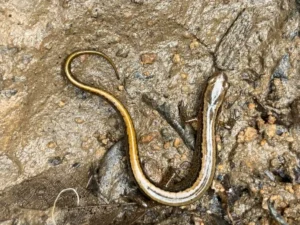You see a salamander move slowly under damp leaves, its small head tilting as if searching for something. It’s careful. Patient. You might wonder, does it look for dead animals like a scavenger, or does it only hunt live prey?
Salamanders are not true scavengers. They mostly catch and eat live prey, though they might take freshly dead or dying animals if the chance is right.
They are hunters first, built to notice and react to movement. Still, life outdoors is unpredictable.
If an easy meal appears (fresh, soft, and safe) they may eat it. But that doesn’t make them scavengers like vultures or crabs.
What “Scavenger” Really Means
A scavenger feeds mostly on dead animals it didn’t kill. These animals often have strong stomachs, sharp senses for finding carcasses, and tools for breaking down tough or rotting food.
Vultures circle over wide areas, looking for carcasses. Hyenas can crush bones. Crabs scrape flesh from shells. They’re built for scavenging as a way of life.

Salamanders are different. They don’t travel far to eat. They don’t tear meat apart. They prefer soft-bodied prey they can swallow whole.
And instead of finding food by scent from far away, they usually find it by sensing movement close by.
Salamanders Are Predators
In the wild, salamanders hunt live prey. Most are active at night, moving through damp leaves, moss, or shallow water. They wait, watch, and strike when something small moves near them.
Many use their sticky tongues to catch insects. Others, especially aquatic species, snap with their jaws.

They usually hunt close to cover, so they can hide again quickly.
Common prey includes:
- Insects: beetles, ants, crickets, flies
- Worms: earthworms, larvae, aquatic worms
- Small invertebrates: slugs, snails, spiders, shrimp-like creatures
- Tiny vertebrates: small fish, tadpoles, sometimes other salamanders
Predation is their main role in the food web. Scavenging is very uncommon happens only when the right moment comes.
Why Scavenging Is Rare
Several reasons explain why salamanders don’t scavenge often:
- Movement matters. They strike when prey moves; still food doesn’t trigger natural feeding response.
- No tearing tools. They swallow whole, so large or tough carcasses aren’t practical.
- Risk of rot. Dead animals can carry bacteria or parasites. Salamanders don’t have the strong stomachs scavengers use to handle this.
- Plenty of live food. Healthy habitats have enough insects and worms to hunt.
Scavenging behavior is uncommon in salamanders because they are not adapted for competing with faster or more specialized scavengers like birds, mammals, or insects.
Even so, nature doesn’t follow strict rules, and salamanders sometimes break them.
When They Might Eat Dead Prey
Scavenging, when it happens, is opportunistic. If food is fresh, small, and soft, they may eat it.
For example, a salamander might feed on a dead insect or worm lying in its path. However, they do not actively seek out dead prey or rely on scavenging to meet their nutritional needs.
This can happen during:
- Food shortages: drought, winter, or degraded habitats
- Aquatic feeding: scent in water can lead them to fresh remains
- Captivity: pre-killed prey offered by keepers
- After another predator’s kill: injured or abandoned prey nearby
It’s not a lifestyle, it’s taking advantage of a moment.
Hunting vs. Opportunistic Feeding
Feeding can look like scavenging when the prey is weak, injured, or freshly dead.
The difference is intent:
- Hunting: seeking and striking live prey
- Opportunistic feeding: eating something already dead because it’s easy and close
Unlike true scavengers, salamanders don’t rely on dead prey to live.
How Habitat Affects Feeding
Where a salamander lives shapes its diet:
- Forest floors: insects and worms are plentiful, scavenging is rare
- Streams and ponds: seasonal changes can reduce live prey, scavenging slightly more likely
- Urban edges: loss of habitat and food may increase opportunistic feeding
In healthy places, hunting dominates. In stressed places, rules bend.
Senses and Food Choices
Salamanders rely on smell, taste, and vibration detection. They don’t have external ears like we do, but they can feel movement through the ground or water.

For most, movement is the main trigger, which is why scavenging on land is rare. In water, smell matters more.
Aquatic salamanders can follow the scent of fresh prey drifting nearby.
Captivity vs. Wild
In captivity, keepers often feed pre-killed prey for safety and convenience. Salamanders learn to accept it when it’s placed close or moved to mimic life.
In the wild, they get no such help, they hunt.
Salamanders’ Ecological Role as Predators
Salamanders are important to ecosystems because they act as mid-level predators.
Young salamanders often choose certain kinds of prey (like mosquito larvae), helping to keep invertebrate numbers in check and playing a role in natural pest control.
By hunting insects and other small animals, salamanders help keep forests healthy and food webs balanced.
Salamanders are also food for bigger animals like snakes, birds, and mammals, making them a key part of many food chains.
Their presence helps move nutrients and energy through both land and water habitats.
Conclusion
Salamanders are hunters, with senses tuned to catch live prey. They can, however, take a fresh, easy meal when the moment allows.
Their scavenging is rare, opportunistic, and shaped by habitat, season, and species. In healthy environments, they hunt. In stressed ones, they adapt.
So if you see a salamander eat something that isn’t moving, it’s not turning into a scavenger, it’s just surviving the way nature intended.
Hi, my name is Ezra Mushala, i have been interested animals all my life. I am the main author and editor here at snakeinformer.com.

